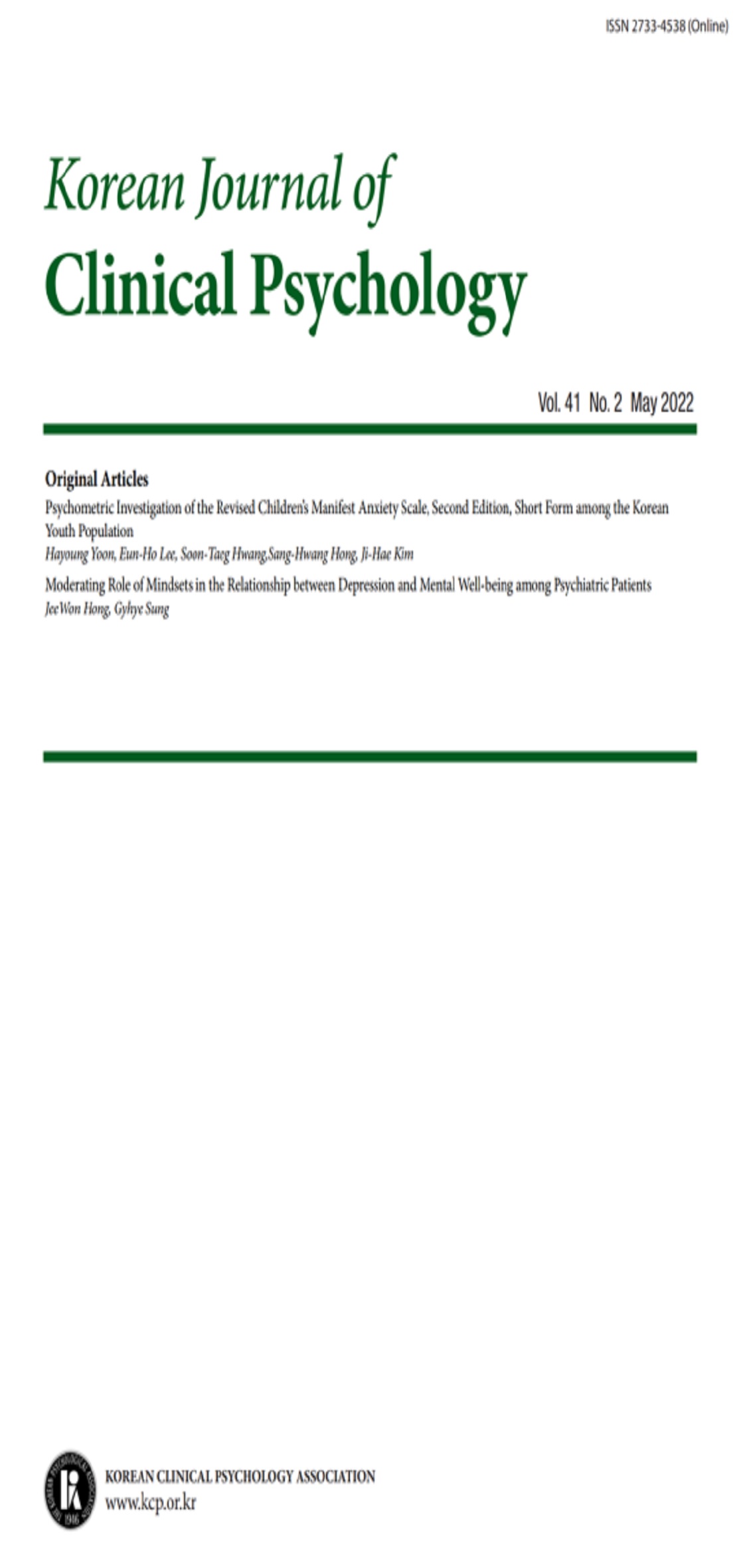open access
메뉴
open access
메뉴 E-ISSN : 2733-4538
E-ISSN : 2733-4538
본 연구에서는 로샤 검사의 통제 관련 변인이 나타나는 패턴에 따라 피검자의 심박수가 어떤 차이를 보이는 지를 살펴보았다. 심박수는 “Polar Heart Rate Monitor System”을 사용하여 측정하였다. 피검자로는 성인 56명(남자 29명 ; 여자 27명)이 자원자로 참여하였다. 피검자들의 로샤 반응을 “EA만 단독으로 나타나는 반응”과 “EA와 es가 공존하는 반응”, “es만 단독으로 나타나는 반응” 그리고 “EA-es 비포함 반응”으로 구분한 후 해당 반응이 나타날 때의 심박수를 비교하였다. 본 연구 결과, 피검자들의 심박수는 안정상태에 비해 로샤 반응 단계동안 증가하였다. 또 피검자들의 심박수는 “es 포함반응” 또는 “EA-es 비포함반응”을 나타낼 때 “EA 포함반응”을 나타내는 경우에 비해 상대적으로 더 크게 증가하였다. 그리고 “EA-es 공존반응”을 보이는 경우 통계적인 검증 결과상에서는 “EA 포함반응”과 유의미한 차이를 보이지 않았으나 전체적인 순위 면에서는 “EA 포함반응”과 “es 포함반응”의 중간 수준의 심박수를 나타내었다. 본 연구 결과는 로샤 검사의 통제 관련 변인, 즉 EA와 es가 나타나는 패턴이 로샤 검사에 나타난 상징적인 반응의 의미를 보다 명료화하는 데 유용한 나침반 역할을 할 수 있음을 시사한다. 연구의 제한점으로 다양한 생리적인 지표를 활용하는 문제와 임상집단을 이용하여 재검증하는 문제가 논의되었다.
The present study examined if there's any difference in heart rates of subjects responding to the Rorschach cards in relation to the actual patterns of control related variables. Heart rate was measured by “Polar Heart Rate Monitor System”. Subjects were 56 adult volunteers(male 29, female 27). All the responses were classified into following four groups; “responses with EA”, “responses with EA-es”, “responses with es”, and “responses without EA-es”. The results are as follows: First, The subjects' heart rates increased during the response phase of the Rorschach test. Second, the subjects' heart rates showed more increase on “responses with es” or “responses without EA-es” than “responses with EA”. Third, heart rates related to “responses with EA-es” ranked in the middle between “responses with EA” and “responses with es”. These results suggest that the pattern of EA and es, the control-related variables can be a compass giving clearer understanding of meaning of symbolic responses on the Rorschach test. Finally, need to verify these results for different clinical groups and with various physiological measures in the future.
(2003) 로샤 검사의 EA 및 es 반응요소 유무에 따른 주관적 평정의 차이,
(1991) Exner 종합체계에 따른 한국정상성인의 Rorschach 반응특성 I,
(1985) Catecholamine selection as a function of perceived coping self-efficacy Journal of Consulting and Clinical Psychology,
(1997) Environmental Psychology ,
(1974) Facial muscle tonus during REM and NREM sleep, Wincor
(1974) The motivational significance of heart rate,
(1992) Rorschach changes following brief and short term therapy,
(1984) Relationships between Rorschach variables as relevant to the interpretation of structural data Journal of Personality Assessment,
(1975) Individual difference in heart rate response to affective sound,
(1995) Self-efficacy as a moderator of perceived control effects on cardiovascular reactivity: Is enhanced control always beneficial? ,
(1980) Effect of harassment and competition upon cardiovascular and plasma catecholamine responses in type A and type B individuals,
(1973) Orienting and defensive response to visual stimuli,
(1954) Developments in the Rorschach technique,
(1980) Cognitive modulation of time dependent primary bradycardia,
(1974) Sympathetic influences on cardiac rate and contractibility during acute stress in humans,
(1952) Rorschach perceptanalytic measurement of personality changer during and after intensive psychoanalytically oriented psychotherapy Specialized techniques in psychotherapy, Basic Books
(2003) Validity and reliability of the heart rate monitors,
(1969) Autonomic indicatings of orienting and defensive reflexes Journal of Experimental Psychology,
(1954) Psychoanalytic interpretation in Rorschach testing, Grune & Stratton
(1998) Principles of Rorschach interpretation, Lawrence Erlbaum Associates
(1991) Rorschach changes in long-term and short-term psychotherapy Journal of Personality Assessment,
